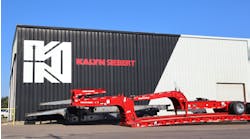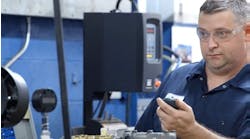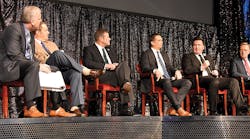Rapid technological change is causing a transformation in the aftermarket. No longer can the mindset be one of doing it in the manner it’s always been done.
To hash out how changes in the OE markets and distributive environments are impacting heavy-duty distributors, HDAD assembled an “Aftermarket Disruptors” panel that included: Scott Gates, senior director/GM, Ryder; Bill Long, president/COO, Automotive Aftermarket Suppliers Association; Bill Nolan, president, PBS Truck Parts; Matt Treadwell, general marketing manager, PACCAR Parts; and Buzz Warner, dealer principal, Warner Truck Centers.
Q: There isn’t any way better to describe what is happening in the business today but disruptors in the aftermarket business. From an aftermarket disruptor standpoint, what would be the one area that gives you the most concern or gives you the most opportunity for you spend the most time on?
Gates: I would probably say the next-generation vehicles and all the technology that’s going to that.
Nolan: I would say technology. We’re strong in our local markets and have got great brand presence. Where we’re way behind is on the technology side. It’s gotten to the point where it’s come down enough in price that everyone of us can afford to invest. We must invest.
Treadwell: That’s a big topic to handle on one choice, but my thought is digital transformation—understanding what’s going on with the digital world. Understanding data and how we approach customers and service them.
Warner: I’m with these guys. The technology piece and utilizing it to save our customers money.
Long: I would say the new and evolving business models that we’re seeing in the aftermarket. That’s a pretty broad runway. Everything from detailing to data analytics, platforms of data warehousing. So disruptive business models would be at the top of my list.
Q: I think technology is probably a pretty interesting area. The world economic forum stated that across all industries, the impact of technology and technological changes is shortening the shelf life of employees and existing skill sets. I think it’s probably hitting everybody that’s answered the question. It will require a new management mindset to meet new challenges within the overall organization. If you look at your organizations, how are you addressing and adjusting to the trends toward telematics, electrification, and emissions-related issues? Scott, you probably run into this more than anyone else with 7000 trucks out there and 600 shops. What are you doing relative to people and training? What do you use for resources?
Gates: Training is obviously critical for all employees. Train and retrain. But finding that person who has the aptitude and ability to learn and understand the new technology and how it’s changed is very important as well. We spend a lot of time working with our partners, providing training to our technicians, to our employees, and customer service reps around technology and what to expect. It’s coming rapidly. Within the next two years, by 2020, I think our business models are going to be very much different than they are today. Definitely continue to train your employees, stay in front of technology. We’ll talk a lot today about technology and things that are changing today in the market, but definitely stay fresh on training and provide them with the tools they need.
Nolan: First of all, I really can’t tell you what we’re going to actually be doing because we’re in the middle of changing our business. We’re really reorganizing ourselves. We rely heavily on our partners. We market in conjunction with our supplier partners, so we need their support. The partners we build relationships with are a big part of our decision-making process with who we do business. That product training is critical because it’s changing more quickly than at any time I can remember since I’ve been in the business. We do have in-house training but a lot of it is with the assistance of our suppliers because that product side is critical.
Q: Bill, from an organization standpoint, is there anything occurring within the buying groups—specifically with the one you’re responsible for—relative to training?
Nolan: No, there has been a lot of talk about how we would do that. It’s certainly been contemplated and we’ve done a lot of brainstorming on it, but we haven’t developed a plan. Our emphasis going forward is back to our first issue—VIPAR is spending a tremendous amount of money in data analytics and ecommerce b2b businesses on the technology piece because that is absolutely critical to parts operations.
Q: Matt, what are you doing as an organization with PACCAR? Where is the responsibility? Is it with the brand? Is it with suppliers? Is it up to the dealers?
Treadwell: I think it’s a mix of all three. It’s a combination. Everybody keeps using the term “partnership.” That’s ultimately what it comes down to. I feel like there are two parts to the question: What are we doing with understanding this move to data and data science, making sure as an OEM we’re doing our responsibility and bringing proper people into our business who understand what’s going on with data science? This last year we created our first data analytics team in the marketing group to really go forward with that data science side. Something like 20% of future employees in the next five years are going to be data scientists, so it’s something we need to get our heads around. Then taking that information technology down to the dealer base and working with them. At PACCAR, we have some fantastic dealers and dealer groups that really go out there and are on the edge with us. I feel like it’s our responsibility to work with our supply base and understand these new technologies we’re putting on vehicles and making sure we’re able to get that information and those training sessions to our dealers. We’re doing a lot of that digitally as well. Last year, we trained 19,000 dealer employees with 500,000 online courses. We’re really focused on advancing training through technology.
Q: Bill Nolan, I know you have an extensive training program in your operation.
Nolan: Training is key for us. We start with the fundamentals on all this technology that’s available. It’s overwhelming for a lot of people. We need to make sure our employees understand the fundamentals first. Once they understand the fundamentals, we have a program to move them through the ranks. There are multiple certifications they can get. From there, you focus on efficiencies. The key for us is once again, stick with fundamentals, then go on from there. The last piece for us will be our good people end up hiring our best technicians. We have a technician that came in, and wanted to change. After six months there, we moved him up, got him his certifications. From there, he hired several of his friends. Fundamentals and training are the key to attracting young talent. If you have a bunch of positive comments from your employees on Facebook, that’s good.
Q: Bill, you have a similar set of challenges.
Long: We launched something at AASA that is kind of a reverse mentoring. We have a whole new generation of young people. Call it Millennials. Most Millennials don’t like the term Millennials, I’m told. But instead of providing leadership mentoring from guys like us, we kind of flipped it and we created a reverse mentoring capability to try to understand what drives this generation, and how do we tap into the innovation, and the technology they’ve grown up with? We provide that service to our supplier base. That’s worked quite well. The key takeaway in the aftermarket right now is the recognition that we’re all in this together.
Q: Buzz, what are you doing from a training standpoint and keeping employees, at least on the service side, recruiting for you? You told me the story of what you’re doing with fleets to keep their capabilities in-house and keep their people up to speed. Can you expand on that?
Warner*: We’ve had some relationships with some of our larger customers going on 30 years now. We know their businesses intimately. It was frustrating to see good people at fleets leave. A good technician ends up at a competitor. Here’s the maximum hourly wage. So we approached one of these customers and said, “Hey, if you’re going to lose him because he needs more money, let us hire the employee. We’ll train them, tool them, get them certified. We will leave them in your shop and your shop manager can direct the workload.” On top of that, we pick up fixed costs, benefits. It’s one less technician we have to recruit and it’s somebody who fits into the culture. They get used to working on the same truck over and over again. We found that the right person in a role like that doing similar repairs day after day can get to 200% efficiency. We’re a flat-rate shop, so if you’re paying that, you’ve doubled that with every efficiency. That’s something we really focus on. If it’s a big repair, we’ll ship it back and put it in a bay at the dealership, but we’re pushing the vast majority of repairs under four hours right in our customers’ shops.
Q: And how many technicians have you picked up?
Warner*: Forty-five that we wouldn’t have had otherwise. It’s the training. And from there, if there’s another up-and-comer, they’ll vouch for you: “Yes, this is a great program. It reduces the head count of the fleet.” They’ll get somebody that’s certified. Daimler has been on board, so you avoid the whole service writeup process and you’ve got parts on the side. It’s been a great program.
Q: What is the advice you would have for the independent parts channel in the future to keep them relevant against the original equipment-connected technology in providing value to the market?
Gates: Parts are a commodity, so if you’re out to sell parts, your business is going to shrink. You’re not going to grow. Selling services to your customers is critical. Whether it’s a small fleet or large fleet, whether it’s having problems with inventory levels or maintenance, if you can build that loyalty, that’s good. Selling parts as we move forward with the competition of all different brands … you’re not going to grow. You probably won’t be around if you’re just selling parts. So consult with your customers and understand their pain points and make sure you provide them with the services and support they need.
Nolan: He’s spot-on. We have to have a relationship with our customers, and that relationship has to be a give-and-take. We had to identify: What can we bring other than just the parts? Our mission statement for our company is “problem solved, promises kept.” So we don’t sell parts. We solve problems. A guy doesn’t get up in the morning and call our sales guy because he just likes him so much that he thinks he wants to order something. He needs to talk. It is about building relationships. It’s about wrapping more into that relationship than just selling parts. A lot of that comes from the advice of the right product for the job you’re doing and having enough knowledge and enough time to explain why it’s so expensive to buy that cheap part.
Q: Relative to the technology side of it, how big of a threat do you view connected technology and telematics and things of that nature to your core business, which is your fleet customers?
Nolan: I guess it can be seen as a threat. It can be seen as an opportunity. There’s always going to be change. Everybody’s going to have to adapt to change and we’re going to have to find our place in that change. I’m optimistic. I think there will be a lot of independent distributors that do wash out because they’re operating on a 30-year-old business model. But a lot of the folks today in VIPAR that I work with are aggressively embracing that change. There’s always going to be a place for an innovative business that is so customer-focused that that’s where they want to do business.
Q: Bill, you have service in your operation. Do you think that’s a must-have for somebody on the independent side going forward?
Nolan: It’s not a must-have. But I think it’s a good thing. It’s a helpful thing. It’s an area where we will probably grow.









